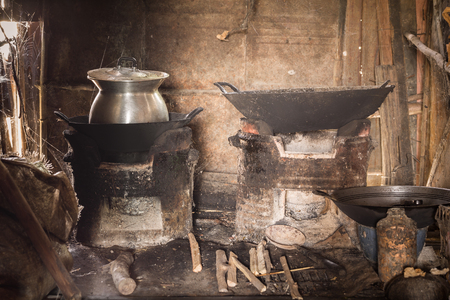Introduction to British Kitchen Evolution
The evolution of kitchen layouts in the United Kingdom reflects not only changes in architectural style and domestic technology, but also shifting social structures and cultural attitudes. From the grand medieval great halls—where cooking, dining, and socialising took place in a single communal space—to the compartmentalised kitchens of the Victorian era and eventually the open-plan designs popular in contemporary homes, British kitchens have undergone substantial transformation. Each period brought about new ways of organising space, influenced by factors such as class distinctions, technological advancements like piped water and electricity, and evolving family dynamics. Today’s British kitchen is often a multifunctional hub at the heart of the home, blending practicality with comfort and style. This historical journey sets the stage for understanding how these physical changes intersect with philosophical systems like Feng Shui, which offer a different lens through which to interpret spatial arrangement and its impact on wellbeing.
2. Victorian and Edwardian Kitchens: Function over Form
During the Victorian and Edwardian eras, the kitchen’s position within UK homes reflected a clear division between social and service spaces. Kitchens were traditionally separated from living areas, often relegated to the rear or basement of a property. This spatial arrangement was deeply influenced by social hierarchies of the time, where domestic work was performed out of sight by servants. The architectural design prioritised practicality, hygiene, and efficiency, foreshadowing the modern utility-focused layouts that would become standard in British homes.
The Traditional Layout: Segregation and Utility
The core objective in Victorian and Edwardian kitchen design was to optimise workflow while maintaining a strict boundary between family life and household operations. The table below summarises key features distinguishing these historical kitchens:
| Feature | Description | Feng Shui Implications |
|---|---|---|
| Location | Rear or basement of the house | Energy (Qi) flow limited; isolation from main living areas may lead to stagnation |
| Separation | Kitchens isolated from dining and entertaining spaces | Reduced interaction; less harmonious flow between nourishment (kitchen) and gathering (dining) |
| Servant Areas | Dedicated sculleries, pantries, and servant corridors | Differentiated energy zones, reinforcing class divisions within household Qi |
| Utility Focused Design | Work surfaces, larders, early plumbing, coal or wood-fired ranges | Efficient but functional; minimal emphasis on comfort or aesthetic harmony |
Social Hierarchies and Early Adoption of Functional Planning
Kitchens of this period were shaped by the presence of live-in staff. The need for privacy, both for homeowners and servants, meant that corridors, back staircases, and discrete access routes were integral to the design. The focus was on enabling seamless meal preparation and cleaning without disrupting the family’s daily routines. This environment prefigured today’s utility-driven kitchen planning but with an added layer of social separation.
Feng Shui Considerations in Historical Contexts
From a Feng Shui perspective, such separation could impede the harmonious movement of energy throughout the home. Kitchens placed far from communal spaces might contribute to a sense of disconnection—both socially and energetically—potentially undermining wellbeing according to traditional Feng Shui principles.
Legacy for Modern Layouts
The legacy of Victorian and Edwardian kitchens endures in many period properties across the UK. While later trends would move towards more open-plan arrangements, understanding these historic layouts offers insight into why certain British homes still feature distinctly compartmentalised spaces today—a consideration relevant when assessing Feng Shui balance in both renovation and restoration projects.

3. Post-war Kitchens: The Rise of Efficiency and the Influence of Modernism
The aftermath of World War II brought about profound shifts in British society, and these changes were clearly reflected in domestic spaces—particularly the kitchen. During this era, rationing persisted well into the 1950s, shaping not only food habits but also how kitchens were designed and used. Space became a premium commodity as new housing was rapidly constructed to replace bomb-damaged stock and accommodate a growing population. The introduction of new materials such as Formica, aluminium, and easy-clean linoleum allowed for surfaces that were both affordable and hygienic, echoing the modernist drive for function and simplicity.
British kitchens of the post-war period were typically compact, with an emphasis on efficiency. The concept of the “kitchen triangle”—placing the cooker, sink, and fridge at strategic points—took hold, inspired by ergonomic studies from both sides of the Atlantic. This layout reduced unnecessary movement and made everyday tasks more manageable, particularly for women who were still seen as primary homemakers despite increasing numbers entering paid work. Socially, there was a marked shift towards privacy; kitchens became more isolated from dining or living areas, reflecting lingering class divisions and traditional ideas about household roles.
From a Feng Shui perspective, these efficient layouts had mixed implications. On one hand, reducing clutter and streamlining movement aligns with principles that advocate for clear energy flow (Qi) throughout the home. However, the emphasis on separation and utility sometimes resulted in kitchens feeling closed off or stark—a potential barrier to positive energy and family cohesion according to classical Feng Shui thinking. In many mid-century British homes, the kitchen’s placement at the back of the house could also mean limited natural light or poor orientation relative to beneficial directions identified in Feng Shui practice.
Overall, post-war British kitchens stand as a testament to resilience and innovation under constraint. Their legacy persists today in many UK homes where compactness and practicality remain key features—reminding us that necessity often drives not just invention, but also the very character of our domestic environments.
4. Contemporary British Kitchens: Open-plan Living and the Island Trend
In recent decades, British kitchens have undergone a significant transformation, reflecting broader social and architectural trends. The shift towards open-plan living has redefined the kitchen’s role within the home, moving away from its traditional status as a closed-off, purely functional space. Instead, kitchens are now designed as social hubs—places for cooking, entertaining, working, and gathering. This move aligns with contemporary values of inclusivity and connectivity among family members and guests.
The Rise of Open-plan Spaces
Open-plan layouts have become increasingly popular in UK homes since the late 20th century. Removing walls between the kitchen, dining, and living areas creates a sense of spaciousness and encourages interaction across activities. Homeowners value the ability to supervise children, converse with guests, or watch television while preparing meals. This design trend also allows more natural light to penetrate deeper into the home, addressing the UK’s often overcast climate.
The Kitchen Island Phenomenon
One of the most notable features of modern British kitchens is the widespread adoption of kitchen islands. These freestanding units provide additional work surfaces, storage solutions, and informal seating. Islands frequently serve as focal points for both culinary tasks and social gatherings. The popularity of kitchen islands is evident across various property types—from suburban semis to urban flats—demonstrating their adaptability to different spatial constraints.
Comparing Traditional vs Contemporary British Kitchen Layouts
| Aspect | Traditional Kitchen | Contemporary Kitchen |
|---|---|---|
| Layout | Closed-off, separate room | Open-plan, integrated with living spaces |
| Main Activities | Cooking only | Cooking, entertaining, working, relaxing |
| Key Features | Larder cupboards, range cooker | Kitchen island, multi-use zones |
| Social Interaction | Limited to family/household members | Enhanced; inclusive of guests & children |
| Lighting | Often dim or artificially lit | Maximised use of natural light |
Cultural Influences and Feng Shui Considerations
The evolution toward open-plan kitchens and the integration of kitchen islands have implications from a feng shui perspective. On one hand, open layouts can facilitate better energy flow (qi), promoting harmony among household members. The central placement of an island can act as a stabilising anchor within the larger space—a principle valued in feng shui for its grounding effect. However, care must be taken with placement: for example, situating an island directly opposite the front door or aligning it with sharp corners may disrupt positive energy circulation according to traditional principles.
Summary Table: Feng Shui Implications of Modern Kitchen Trends
| Design Element | Potential Feng Shui Benefit | Possible Challenge |
|---|---|---|
| Open-plan layout | Smoother qi flow; better communication | Lack of boundaries may diffuse energy too much if not balanced by furniture or decor choices |
| Kitchen island (central placement) | Stabilises energy; encourages social cohesion | If poorly placed, can obstruct movement or create energetic imbalance (e.g., “cutting” chi) |
| Natural lighting enhancements | Lifts mood; supports healthful energy in space | If excessive glare occurs or windows are poorly positioned relative to stove/sink, potential energetic disharmony arises. |
This shift toward flexible, communal spaces marks a new chapter in British domestic design history—one that balances modern lifestyles with longstanding principles of harmony and wellbeing.
5. Feng Shui Principles Applied to Classic and Modern UK Kitchens
Feng Shui, the ancient Chinese art of spatial arrangement, places particular emphasis on the kitchen as a centre of nourishment and family well-being. In the context of British kitchens—both classic Georgian or Victorian layouts and contemporary open-plan designs—applying core Feng Shui principles can yield fascinating intersections and occasional conflicts.
Key Feng Shui Concepts Relevant to Kitchens
Central to Feng Shui is the flow of qi (energy), balance of elements, and optimal positioning of key features. The cooker represents fire, while the sink embodies water; their relationship is crucial. Ideally, these should not be directly opposite or adjacent, as this sets up a clash between fire and water elements, believed to cause discord in the household.
Classic British Kitchen Layouts
Traditional British homes often featured galley or closed kitchens, with limited space and clear separations from dining areas. While such separation aligns with Feng Shui’s preference for keeping cooking energy contained, cramped arrangements sometimes forced cookers and sinks into close proximity—creating potential elemental conflict. Moreover, older kitchens were usually located at the rear of the house, symbolically distancing nourishment from prosperity according to Feng Shui lore.
Modern Open-Plan Kitchens
The modern British trend towards open-plan living presents both opportunities and challenges for Feng Shui practitioners. Positively, open sightlines allow qi to circulate more freely; however, lack of defined boundaries may diffuse beneficial energy or expose food preparation areas directly to the front door—a classic Feng Shui taboo that may “leak” fortune out of the home.
Finding Harmony: Practical Considerations
In adapting Feng Shui to UK kitchens, practical compromise is key. Solutions include strategic placement of kitchen islands to buffer direct lines between cooker and sink, use of screens or plants to subtly define zones in open spaces, and careful selection of colour palettes to enhance elemental balance. While not all traditional advice translates seamlessly into British architecture, thoughtful application can support both cultural heritage and contemporary living standards.
6. Practical Feng Shui Adaptations for British Homes
Given the unique evolution of kitchen layouts in the UK—ranging from Georgian sculleries to modern open-plan designs—many homeowners face architectural limitations when applying traditional Feng Shui principles. However, with a practical and experimental mindset, it is possible to make meaningful adaptations that respect both British heritage and Feng Shui wisdom.
Respecting Historical Features While Enhancing Flow
Older British homes often feature compact kitchens with limited natural light, thick walls, and awkward alcoves. Instead of drastic structural changes, consider subtle adjustments. For example, use reflective surfaces such as glass splashbacks or polished worktops to encourage the flow of energy (qi) and bounce available light around the space. Where period features like fireplaces or original tiling exist, highlight these elements respectfully—they can serve as grounding focal points while reinforcing a sense of history and stability.
Optimising Layout Within Constraints
The ideal Feng Shui kitchen places the stove in a commanding position with visibility of the entrance. In many British homes, this is not structurally feasible. As an alternative, install a mirrored panel behind the hob or cooker; this allows you to “see” the entrance while cooking, symbolically restoring control and awareness without major renovations. Additionally, keep pathways clear of clutter and avoid positioning bins or cleaning supplies directly opposite main entrances to minimise stagnant or negative energy.
Material Choices and Colour Harmony
Choose materials that harmonise with both the home’s historical character and Feng Shui’s elemental theory. Wooden cabinets evoke growth and vitality, while stone or slate flooring offers grounding earth energy—both commonly found in UK homes. To offset grey skies and boost yang energy, introduce warm accent colours such as ochre, sage green, or terracotta through textiles or small appliances.
Adapting to Modern Lifestyles
For contemporary open-plan kitchens—a popular trend in recent UK architecture—define functional zones using rugs, pendant lighting, or changes in cabinetry finish. This approach maintains energetic boundaries between cooking, dining, and living areas while supporting family cohesion (a key Feng Shui goal). Plants like herbs on window sills bring vibrancy and fresh qi into even the smallest spaces.
Actionable Steps for Immediate Impact
- Declutter countertops regularly to promote clarity and free movement of energy.
- Repair leaky taps promptly; water represents wealth in Feng Shui.
- Add soft furnishings to absorb sound in echo-prone Victorian kitchens.
- Keep knives stored out of sight to reduce tension and foster safety.
Ultimately, the most effective Feng Shui solutions for UK kitchens are those that blend time-honoured wisdom with sensitivity to local architecture and daily life. By experimenting with small changes—while respecting both tradition and practicality—British homeowners can enjoy more harmonious and uplifting kitchen environments.


